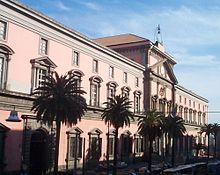Naples National Archaeological Museum
| Museo Archeologico Nazionale di Napoli | |

Naples National Archaeological Museum
|
|
| Established | 1750s |
|---|---|
| Location | Piazza Museo, Naples Italy |
| Type | archaeology |
| Public transit access | Fermata Museo (Metropolitana linea 1) Fermata Piazza Cavour (Metropolitana linea 2) |
| Website | Official website |
The Naples National Archaeological Museum (Museo Archeologico Nazionale di Napoli, MANN) is a museum in Naples, southern Italy, at the northwest corner of the original Greek wall of the city of Neapolis. The museum contains a large collection of Roman artifacts from Pompeii, Stabiae and Herculaneum. The collection includes works of the highest quality produced in Greek, Roman and Renaissance times. It is the most important Italian archaeological museum and is considered one of the most important in the world.
Charles of Bourbon founded the museum in the 1750s. The building he used for it had been erected as a cavalry barracks and during its time as the seat of the University of Naples (from 1616 to 1777) was extended, in the late 18th century.
The museum hosts extensive collections of Greek and Roman antiquities. Their core is from the Farnese Collection, which includes a collection of engraved gems (including the Farnese Cup, a Ptolemaic bowl made of sardonyx agate and the most famous piece in the "Treasure of the Magnificent", and is founded upon gems collected by Cosimo de' Medici and Lorenzo il Magnifico in the 15th century) and the Farnese Marbles. Among the notable works found in the museum are the Herculaneum papyri, carbonized by the eruption of Mount Vesuvius, found after 1752 in Villa of the Papyri.
The greater part of the museum's classical sculpture collection largely comes from the Farnese Marbles, important since they include Roman copies of classical Greek sculpture, which are in many cases the only surviving indications of what the lost works by ancient Greek sculptors such as Calamis, Kritios and Nesiotes looked like. Many of these works, especially the larger ones, have been moved to the Museo di Capodimonte for display in recent years.
...
Wikipedia
